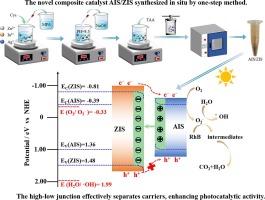Enhanced visible-light-driven photocatalytic degradation via in-situ AIS/ZIS high-low junctions
IF 4.3
2区 化学
Q1 SPECTROSCOPY
Spectrochimica Acta Part A: Molecular and Biomolecular Spectroscopy
Pub Date : 2024-11-05
DOI:10.1016/j.saa.2024.125392
引用次数: 0
Abstract
The I-III-VI QDs Ag-In-S (AIS) exhibits excellent properties in photocatalysis because of the adjustable band gap, wide light absorption range, and multiple active sites. Introducing homologous or heterogeneous ions not only derives the composition into quaternary/ quinary quantum dots but also generates new sulfide QDs to form composites, which is an effective strategy to promote photoactivity. In this work, we in-situ synthesized the AIS/ZIS (AgIn5S8/Zn4In2S7) composite photocatalyst by introducing Zn2+ and changing the reaction temperature. We found that the composite photocatalyst could efficiently photodegrade larger concentrations of RhB than that of the previous reports. The superior photocatalytic activity was due to the formation of the type I high-low junction, which could effectively separate carriers. The photoelectrons on the CB of AIS reacted with dissolved oxygen to produce strongly oxidative ![]() O2–, which degraded RhB into intermediates and eventually into CO2 and H2O. This work not only reports an excellent photocatalyst but also offers new ideas on the design and manufacture of highly efficient high-low junction photocatalysts.
O2–, which degraded RhB into intermediates and eventually into CO2 and H2O. This work not only reports an excellent photocatalyst but also offers new ideas on the design and manufacture of highly efficient high-low junction photocatalysts.

通过原位 AIS/ZIS 高低结增强可见光驱动的光催化降解。
I-III-VI QDs Ag-In-S (AIS) 具有可调带隙、宽光吸收范围和多个活性位点,因此在光催化方面表现出优异的性能。引入同源或异源离子不仅能衍生出四元/二元量子点组成,还能生成新的硫化物量子点,形成复合材料,是提高光活性的有效策略。在这项工作中,我们通过引入 Zn2+并改变反应温度,原位合成了 AIS/ZIS (AgIn5S8/Zn4In2S7)复合光催化剂。我们发现,与之前的报道相比,该复合光催化剂能有效光降解更高浓度的 RhB。这种优异的光催化活性得益于 I 型高低交界的形成,它能有效地分离载流子。AIS CB 上的光电子与溶解氧反应,产生强氧化性 O2-,将 RhB 降解为中间产物,并最终降解为 CO2 和 H2O。这项工作不仅报告了一种优秀的光催化剂,还为设计和制造高效的高低交界光催化剂提供了新思路。
本文章由计算机程序翻译,如有差异,请以英文原文为准。
求助全文
约1分钟内获得全文
求助全文
来源期刊
CiteScore
8.40
自引率
11.40%
发文量
1364
审稿时长
40 days
期刊介绍:
Spectrochimica Acta, Part A: Molecular and Biomolecular Spectroscopy (SAA) is an interdisciplinary journal which spans from basic to applied aspects of optical spectroscopy in chemistry, medicine, biology, and materials science.
The journal publishes original scientific papers that feature high-quality spectroscopic data and analysis. From the broad range of optical spectroscopies, the emphasis is on electronic, vibrational or rotational spectra of molecules, rather than on spectroscopy based on magnetic moments.
Criteria for publication in SAA are novelty, uniqueness, and outstanding quality. Routine applications of spectroscopic techniques and computational methods are not appropriate.
Topics of particular interest of Spectrochimica Acta Part A include, but are not limited to:
Spectroscopy and dynamics of bioanalytical, biomedical, environmental, and atmospheric sciences,
Novel experimental techniques or instrumentation for molecular spectroscopy,
Novel theoretical and computational methods,
Novel applications in photochemistry and photobiology,
Novel interpretational approaches as well as advances in data analysis based on electronic or vibrational spectroscopy.

 求助内容:
求助内容: 应助结果提醒方式:
应助结果提醒方式:


